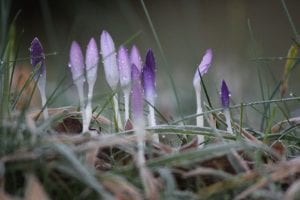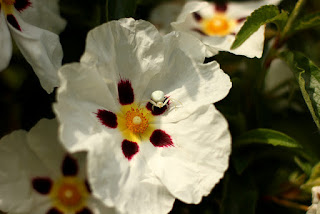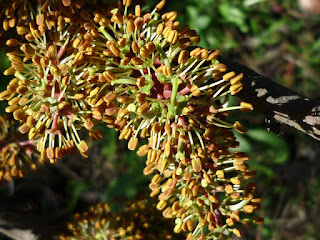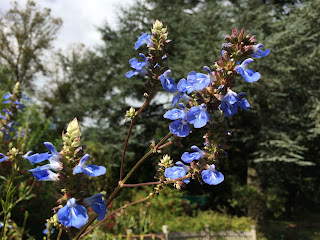By Helen Roberts
The peony has undeniably beautiful flowers, from the perfect spherical bud giving a hint of the petal colour underneath to the rapid unfurling of immense blooms. Even the foliage is attractive, particularly towards the end of the season when they readily take on autumnal tints.
I admire them in gardens that are not my own for I have never grown peonies, the tree nor the herbaceous species. The flowers, although staggeringly large and of sublime colours and subtle scents, are too short lived for my own small garden. After all peonies need space. However, I am looking forward to the development of a new peony garden in the University of Bristol Botanic Garden. It will form part of a new ‘Culture’ display, which is being implemented this year with the help of the Chinese Garden co-ordinator, Tony Harrison, who is a traditional Chinese herbalist.
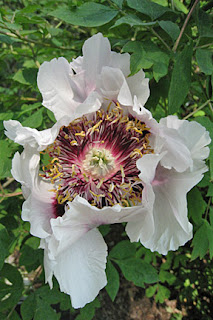 |
| Tree peony. Image credit: RHS |
Peonies are native to Asia, Southern Europe and North America and are contained within the Paeoniaceae family. There are 4 different types, the tree peony, herbaceous peony, the hybrids and the intersectional peonies, which are crosses of tree and herbaceous peonies. Tony explains the different species of tree peonies [1]:
‘When they first arrived, the Chinese tree peony was thought to be a single species which was named Paeonia suffructicosa, but research showed P. suffructicosa to be a hybrid which has been derived from at least three main species which have been interbred over several thousand years to produce the wide range of cultivars from different regions of China. These original source species were then separated into three separate wild species as P. ostii, P.jishanensis and P. yunanensis.’
A number of species will be cultivated in the new peony display at the Botanic Garden. These will include ones from different regions of China including the wild species of P. ostii, P. jishanensis and P. yunanensis as well as P. delavayi, P. rockii and P. suffructicosa, and several herbaceous species.
A long history of medicinal use
Peony tubers have been used for medicinal purposes for centuries. The bark of the roots is used to treat congestion, blood disorders and worms [2]. Tony explains the importance of peonies in Chinese medicine:
‘Peonies were being used in medicine long before they were cultivated for ornamental purposes. It is considered that peonies have been used medicinally dating back about 2,000 years. The root bark of the tree peony is used to cool and move the blood, whereas the herbaceous peony is used to tonify the blood. The Chinese name for peony is mudan (牧丹) and the characters can be translated to mean the colour “red” but also “medicine” and “healing”. The bark is separated from the remainder of the root, chopped, dried and used in combination with other substances.’
The plant is also revered for its attractiveness. The flower colours range from yellow, cream, red, pink; all the way to lavender and near black [3]. Some have a unique, almost peppery and spicy, scent. I am fond of the smell, it is not cloying or overpowering like some flower scents. The choice of peony hybrids and cultivated varieties is vast, there are so many to choose from. The herbaceous peonies are more commonly grown in Europe and North America and because of this familiarity with the herbaceous form, tree peonies are not as popular. I prefer the tree peonies as they offer interesting foliage and architectural form.
The tree peony has been grown for its flowers in China since the 6th and 7th centuries during the Sui (581-618 AD) and Tang dynasties (618-906 AD) when it appeared in the imperial palaces. It is rumoured to be one of the first flowers to be cultivated purely for its ornamental purposes from the ancient city of Luòyáng and the seat of the Sung dynasty (960-1279 AD), hence it is often called luòyànghuā or flower from Luòyáng [2]. The enthusiasm during the Sung dynasty for peonies is comparable to the tulip mania that gripped Holland in the 17th century and immense sums where paid for highly prized peonies. In Luòyáng many peony exhibitions and shows are still held there annually. Peonies in China are normally cultivated by planting in terraces or raised beds and protected from the harsh summer sun by mat awnings [2].
The symbolism of the peony
Along with many other flowers grown in China, the peony is shrouded in layers of symbolism. Among the tree peonies (Peonia suffruticosa), the male vermilion flower is known as the ‘King of Flowers’ (花王 hūawang) and represents both royalty and aristocracy [2]. The tree peony was originally grown by royalty, the aristocracy and eventually, over time, throughout China. In the imperial palaces, it was often displayed in opulent reception halls, being used as a table plant in large vases. The ink and deep red forms as well as a variety with a yellow edge on the petals, known as the ‘Golden border peony’ were highly valued [4]. The peony is also called fùguìhūa (富貴花), the flower (hūa) of wealth (fù) and rank (guì) symbolising wealth, social status and honour [2]. Despite being associated with the yang principle (male) of masculinity and brightness it also represents female beauty and reproduction, especially erotic lushness [5].
 |
The flowers of the four seasons – the tree peony is spring.
Image: Jimmie on Flickr [CC By 2.0] |
The tree peony is one of four flowers which symbolise the seasons; tree peony – the spring (and March); the lotus – summer; the chrysanthemum – autumn; and the plum – winter.
The herbaceous peonies are termed the ‘Prime Minister of All Flowers’ and are also highly prized.
As well as using the plant form itself, peonies have long been depicted in Chinese art forms (literary and visual) for centuries and they form one of the main motifs in silk tapestries, paintings, lacquerware and clothing. They are often displayed alongside peacock, pheasant, fowl, phoenix and lion to represent splendour, status and nobility [2].
Such is the importance of peonies in Chinese culture that numerous stories and poems have been written and told. There is the wonderful fable of ‘The Fabulous Peony’, where the wicked and vain Empress Wu Zetian ordered all flowers in the Imperial garden to bloom overnight in winter and those that did not would be punished. The senior member of the Imperial garden, the Male Vermillion Peony refused to obey, whilst the other flowers in the garden submitted and duly produced blooms to please Empress Wu.
In her fury at being disobeyed, the peony was banished from the Imperial Palace and anyone growing it would be put to death. To save the peony from destruction the royal gardener, Pei Fu sent roots of the peony to a friend in Luoyang, a place considered lacking in culture and hence not likely a place to arouse suspicion. And here the peony flourished, the peony gardens at Luoyang remaining a secret until the death of the Empress Wu when it emerged out of hiding [6].
Helen Roberts is a trained landscape architect with a background in plant sciences. She is a probationary member of the Garden Media Guild and a regular contributor to the University of Bristol Botanic Garden blog.
References:
[1] Harrison, T. Varieties of Peony. Journal Archive. The Register of Chinese Herbal Medicine.
[2] Williams, C.A.S., 2006. Chinese Symbolism and Art Motifs: A Comprehensive Handbook on Symbolism in Chinese Art Through the Ages. Tuttle Publishing.
[3] Fearnley-Whittingstall, J., 1999. Peonies. Harry N. Abrams.
[4] Li, H.L., 2012. Chinese flower arrangement. Courier Corporation.
[5] Welch, P.B., 2013. Chinese art: A guide to motifs and visual imagery. Tuttle Publishing.
[6] Chew, K., 2008. The Magical Dumplings and Other Chinese Fables. iUniverse.
